
Valleriana: La Svizzera pesciatina e "Le Castella"
Tempo consigliato per la visita: almeno una giornata
Itinerario: San Lorenzo a Cerreto, Pietrabuona, Medicina, Fibbialla, Aramo, San Quirico, Castelvecchio, Stiappa, Pontito, Sorana, Vellano.
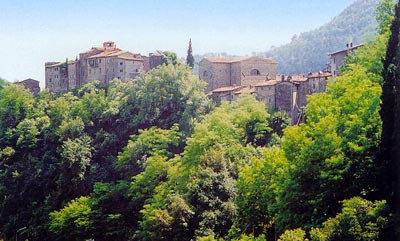
- Pietrabuona
Le Dieci Castella
A nord del Comune di Pescia si trova il territorio dell'alta valle del fiume omonimo, chiamata da sempre Valleriana. Rinominata dal ginevrino Sismondi , giunto esule a Pescia alla fine del secolo XVIII, "Svizzera Pesciatina", è senza dubbio una delle zone più belle della Valdinievole. Per raggiungere questa regione bisogna prendere la via Mammianese nord, direzione Pietrabuona-Abetone. . Superata una zona abbastanza pianeggiante, è possibile vedere alla propria destra al di là del fiume, la chiesa romanica di S. Lorenzo a Cerreto. Più avanti dopo circa 2 km ci dà il benvenuto la porta naturale della "Svizzera Pesciatina", il paese di Pietrabuona. Situato su un poggio in posizione strategica, nel medioevo il paese è stato luogo di sanguinose battaglie fra fiorentini e pisani. Nella parte bassa è visitabile il Centro di documentazione della carta e a seguire l'antica cartiera "Le Carte" sede del museo della carta, che raccoglie le testimonianze di una secolare e prestigiosa attività. La chiesa è dedicata ai santi Matteo e Colombano e conserva al suo interno due statue lignee molto antiche che rappresentano S. Matteo e S. Michele. Nella zona retrostante alla moderna architettura è ubicata l'antica chiesa all'interno del castello.
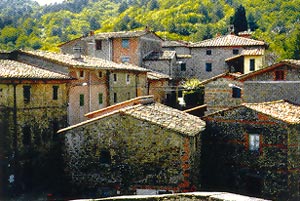
- Medicina
Immettendosi nella strada della Val di Torbola e deviando poi sulla sinistra si raggiunge il paese di Medicina. Il castello è noto per l'antica chiesa dedicata ai S.S. Sisto e Martino. Costruita nel XV secolo corona l'alta collina boscosa sulla cui sommità si distende l'abitato sul quale svetta il campanile della chiesa, che si suppone fosse un'antica torre di guardia. Ritornando sulla strada della Val di Torbola si raggiunge poi il paese di Fibbialla di Valleriana. L'entrata è segnata dalla rettoria di S. Michele, attorno alla quale si articola l'abitato. All'interno sono custodite alcune tele sei-settecentesche di un certo interesse ed una scultura quattrocentesca raffigurante la Vergine Annunziata.
Dopo Fibbialla troviamo il castello di Aramo. Sorge su di un picco a strapiombo sulla sottostante val di Torbola; il paese è stato teatro più volte di aspre contese intorno al '400, saccheggiato e in gran parte distrutto. Al culmine dell'abitato sorge la chiesa di S. Frediano.
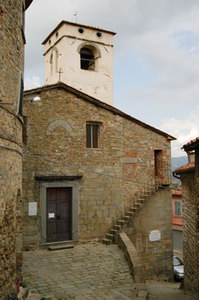
- scorcio di Fibbialla
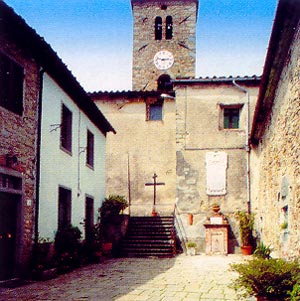
- scorcio di Aramo
Riprendendo l'itinerario ben presto si arriva a S. Quirico. Si tratta di uno dei più bei castelli della Valleriana. Collocato sul versante orientale del Monte Battifolle, è un paese che offre la vista di tutte le valli.
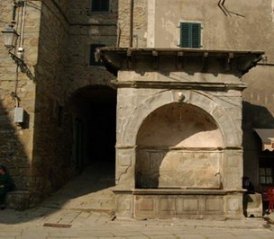
- scorcio di San Quirico
Nel centro troviamo suggestivi vicoli che si incrociano e passano ora sotto le abitazioni attraverso piccoli tunnel, ora presso incantevoli pergole o tettoie. Nella parte più alta del paese si trova una bella piazza arredata da una fontana in pietra con una vasca quadrangolare. In posizione più bassa si trova la chiesa dedicata ai SS. Quirico e Giuditta.
Scendendo da S. Quirico : dopo pochi chilometri si scorge l'opera d'arte più nota di questo territorio: la pieve dei S.S. Tommaso e Ansano di Valleriana, dichiarato monumento nazionale nel 1875. Un mistero avvolge questa Pieve che sembra testimoniare con la sua solennità architettonica il perdurare della storia antica. Documentata sin dal IX secolo, purtroppo non conserva che pochi reperti dell'antichissima struttura. Ricostruita più volte possiede oggi una forma stilistica piacevole che ricorda l'architettura religiosa lombarda del XII secolo. Nel centro del paese di Castelvecchio si trova l'Oratorio del SS. Rosario, interamente decorato da Storie della Vergine e di Cristo, si tratta di un buon fresco fiorentino di ignoto, databile intorno al XVI sec.; raggiungibile da una piccola mulattiera è posto sotto la chiesa parrocchiale di San Giovanni Battista, dove attualmente viene officiata la Santa Messa e al cui interno, strutturato con tre piccole navate, è da segnalare l'altare in stucco policromo dove è ubicato il tabernacolo in legno finemente decorato a foglia oro. Dietro l'altare vi è una pala d'altare, di provenienza dalla Pieve, raffiguranti i Santi Giovanni e Tommaso ai piedi della Madonna con Bambino sul trono datato intorno al XVI sec.. Sul lato destro il crocifisso ligneo con Cristo Sofferente del XVII sec. e il fonte battesimale scolpito in pietra serena. Il Borgo, di origine medievale mantiene della sua primitiva struttura fatta di suggestive vie castellane che si inerpicano sino alla Chiesa di S. Ansano.
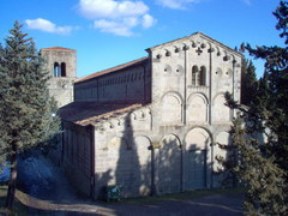
- Pieve romanica di Castelvecchio
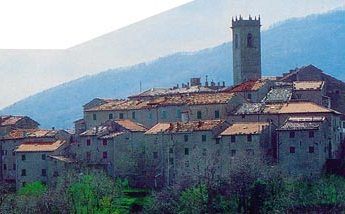
- Stiappa
Ritornando sulla strada maestra si prosegue per il paese di Stiappa. Ubicato sulle pendici del monte Battifolle, a 627 metri di altezza, l'antico paese ha segnato per secoli il confine tra il Granducato di Toscana e il Ducato di Lucca. La chiesa di S. Maria Assunta sorge in posizione elevata. L'architettura ecclesiastica denuncia un forte richiamo all'arte romanica. Da Stiappa si scende fino al Mulino del Fontanone, per un percorso di trekking chiamato la "Via del mulini".
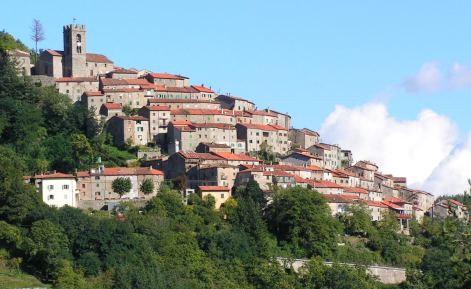
- Pontito
L'itinerario prosegue fino a Pontito un luogo davvero magico. Il castello (a 749 metri sul livello del mare) noto sin dal IX secolo come possesso dei vescovi di Lucca, sorge presso la sorgente del fiume Pescia. Il borgo ha conservato integro l'impianto fortificato; all'interno l'abitato si articola secondo un particolare andamento piramidale al cui vertice si erge la Chiesa dei SS. Andrea e Lucia, robusta costruzione in pietra di origine romanica. Una passeggiata all'interno di questo paese, la cui forma ricorda un ventaglio rovesciato, adagiato sulla morbida natura incontaminata, svelerà all'occhio del più attento visitatore segni artistici di notevole livello che un tempo esprimevano la dignità del luogo.
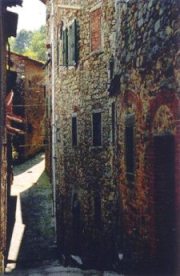
- scorcio di Sorana
Ritornando indietro sulla strada maestra, si può raggiungere il paese di Sorana attraversando il fiume. L'antico borgo, adagiato sulle pendici del Monte Petritulo, prende il nome dalla rocca, della quale rimangono oggi soltanto alcuni resti e che un tempo era detta "sovrana" per la sua posizione a dominio della vallata. La particolare pianta ellittica del borgo culmina nella piazza dove è situata la Chiesa dedicata ai Santi Pietro e Paolo.
Celebre per la produzione del Fagiolo di Sorana Igp, un particolare tipo di fagiolo dal gusto delicato ( www.fagiolodisorana.org ), il paese è oggi meta di buongustai a caccia di prelibatezze. Nel mese di agosto, la famosa e tradizionale "Festa del Fagiolo".
Prendendo la strada principale che riconduce alla via Mammianese, si possono vedere alcuni stabilimenti per la lavorazione della carta che un tempo furono veramente la gloria dell'imprenditoria locale. La cartiera più famosa è quella Magnani. L'azienda, che vanta antichissime origini, fino a pochi anni fa produceva carta pregiata, lavorata a mano per edizioni di alto pregio e carta moneta per la zecca italiana. . Ripresa quindi la via Mammianese, dopo una serie di tornanti appare unico nella sua severità urbanistica, il paese di Vellano..
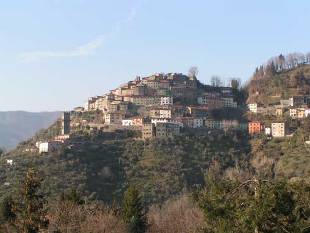
- Vellano
Vellano, capoluogo riconosciuto della Svizzera Pesciatina e un tempo rinomata località di villeggiatura, il paese - antico Avellanum - sorge in posizione panoramica sulla valle del fiume Pescia. Noto per la sua Pieve già dal X secolo fu un tempo feudo della famiglia Garzoni, nel 1336 Coluccio Salutati redasse quegli statuti che per lungo tempo ne sancirono le caratteristiche amministrative.
Nella parte sottostante al castello, fuori dalle mura, si trova la pieve dei SS. Sisto e Martino, che un tempo era annessa ad una antichissima abbazia benedettina.
A Vellano è rimasta l'unica cava di Pietra Serena in funzione nella provincia di Pistoia.
Oggi nella "Cava Nardini" si continua ad estrarre da oltre 100 anni il prezioso materiale ed a produrre ogni tipo di manufatto, secondo le lavorazioni tradizionali: dal semplice materiale da costruzione, ai manufatti da arredamento e perfino alle sculture, da considerarsi vere e proprie opere d'arte.
Si consiglia una visita al "Museo Storico Etnografico del Minatore e del Cavatore" che espone arnesi da lavoro ed una ricca collezione di minerali.

THE VALLERIANA AREA AND THE 10 HAMLETS
Valleriana (between 100 and 800 metres above sea level) is a really fascinating and peculiar place located on the Apennines north of the town of Pescia. Here, there are plenty of olive, chestnut (once at the core of the local agricultural economy), oaks and locust trees.
In the woods there are 10 medieval hamlets, known as "castella": Pietrabuona, Medicina, Fibbialla, Aramo, Sorana, San Quirico, Castelvecchio, Stiappa, Pontito and Vellano.
Built between the end of the IX century and the beginning of the X century along an ancient route between Val di Lima and Val di Nievole, the hamlets were made of a local stone, pietra serena, for which this area used to be well-known: a wonderful, sober, ductile and metallic-coloured material.
The 10 hamlets are all surrounded by fortified walls, some of which are well-preserved and their medieval origins are easily identifiable. They are linked to one another both by a paved road and trekking routes.
The typical products of the area are Sorana beans, mushrooms, oil, chestnuts and honey. This area is also famous for the livestock of "cinta senese", a first-rate Italian meat (pork).
Sheep livestock is still practised in the area as well as the production of pecorino.
During the year, there are several food fairs and country festivals where it is possible to taste traditional receipts made with typical products. For instance, we may recall the festivals dedicated to necci (neccio is a chestnut crêpe rolled around ricotta cheese), boar meat, becuttino (becuttino is a rice fritter), beans but also medieval dinners.
Pietrabuona
Pietrabuona is the first village that we encounter when leaving Pescia; indeed, it is the natural gateway of Valleriana. Because of its strategic position, in the Middle Ages, several battles between Lucca and Florence took place in Pietrabuona. Its name literally means "good stone" and it is due to its now abandoned quarries of pietra serena. The village walls are still visible in part, as well as the citadel and one of the entrance doors.
In the part of the village called Bicciuccolo, is a square where the main church is located. In the lowest part of the hamlet is the Centre of documentation on papermaking, while in the nearby old paper mill, "Le Carte", you may take a look at the old equipment and other materials used for papermaking, the majority of which dates back to the XVIII century. These equipment and materials are a valuable witnesses of this century-old and prestigious activity, developed starting from the XV century along the Pescia river, where today there are some firms still operative in this sector.
Not to miss: Saint Lorenzo Church, Museum of the papermaking, Piazza della Croce, Piazza di Castello, Saints Matteo and Colombano church
Medicina
Medicina was once a military outpost. Indeed, historians believe that Saints Sisto and Martino parish church's bell tower, located at the top of the village, used to be a stone watchtower in the Middle Ages. A few ruins of the village walls, the semi-circular defensive towers and the ancient gateway are the only remains of fierce battles between Lucca and Florence.
Medicina, still today surrounded by chestnut woods and olive groves, is characterised by the presence of the so called "terrazzo-aie", open spaces where people used to dry agricultural products.
The view from the castle is breathtaking since it stands on a wooden hilltop in a scenic location.
Not to miss: Saints Sisto and Martino church, Piazza S. Martino
Fibbialla
Fibbialla is located in a scenic position, overlooking Pescia river's valley. It is one of the best-preserved villages in Svizzera Pesciatina, due to the radical depopulation of the last decades. Small rapacious birds, such as buzzards and kestrel, often cross the sky over Fibbialla.
Take the time to visit Saint Michele church; inside, it is possible to admire a fifteenth-century sculpture representing Our Lady of the Annunciation.
Not to miss: Saint Michele church and Saint Michele square.
Aramo
Aramo, on top of a steep hill overlooking Val di Torbola, once harshly contended between Lucca and Florence, is still extremely suggestive due to its position and structure.
Take time to visit Saint Frediano church and the Oratory dedicated to the Nativity of the Virgin Mary, located right out of the village. The church dedicated to Saint Frediano hosts a few noteworthy XVI-XVII century sacred vessels and vestments.
The village is surrounded by chestnut woods and old facilities that were once used for the economic activities of the area: spaces for the charcoal pits, triangular-shaped huts for tools and, last but not least, the so-called metati, typical small houses made of stone where fruits were dried and later used to preserve chestnut flour with which still today typical dishes are made, such as necci, frittelle, polenta dolce, castagnaccio..etc
Not to miss: Virgin Mary church, Saint Frediano church, Saint Frediano square
Sorana
The village, laid down on the slope of Monte Petritulo, gets its name from the fortress that used to be called "sovrana" (sovereign) due to its strategic position.
In the main square, take time to visit the church dedicated to Saints Paolo and Frediano, built in pietra serena and whose façade is decorated with a fifteenth- century fresco.
Today, Sorana is famous for the limited production of a particular kind of bean, with a really thin peel and a delicate flavour that has earned it the IGP label.
Not to miss: Saints Pietro and Paolo church, Saint Pietro square
Restaurants where you can taste Sorana beans: "Da Sandrino" and "Da Carla"
Stiappa
The old castle, located on the slopes of Monte Battifolle, at 672 meters height, has marked for centuries the border between the Grand Duchy of Tuscany and the Duchy of Lucca. The untouched urban structure reveals the medieval origins of the hamlet. You should take time to visit Saint Maria Assunta church, with its Romanesque structure and its dominating position. It hosts a painting dating back to the middle of the XVII century and representing the Assumption of the Virgin Mary.
Through a trekking route called Via dei Mulini (literally mill road), you can reach Mulino del Fontaione.
Not to miss: Saint Maria Assunta church - Piazza Grande
San Quirico
San Quirico is located on the eastern slope of Monte Battifolle which offers a view of the surrounding valleys, thus making the village a strategic location. Historians believe that San Quirico dates back to the first half of the XIII century.
In the upper part of the village is the main square with a lovely stone-fountain, while the church dedicated to Saints Quirico and Giuditta is located in the lower part. The church still preserves traces of Romanesque architecture and inside, it hosts a rare work of art: an hexagonal-shaped baptismal font, made of pietra serena, probably dating back to 1000. Take time to walk along the picturesque meandering lanes, past lovely bowers and shelters. Along the narrow alleys, there are a lot of small oratories where the local religious brotherhood used to work and animate the religious life of the castle. Furthermore, a lizard-shaped coat of arms is still visible on a wall located in the part of the village known as Orticino. This coat of arms was the symbol of bronze craftsmen and was reproduced in every bronze craft foundry of the village, once famous for bells manufacturing.
Not to miss: Saints Quirico and Giuditta church - Garibaldi square
Castelvecchio
Castelvecchio is 430 meters above sea level. From Castelvecchio, you may reach Monte Battifolle (1109 metres) by foot; on its summit, notice the ruins of the ancient castle that used to be the defensive citadel of the Duchy of Lucca.
Take time to visit the beautiful parish church dedicated to the Saints Battista and Tommaso, dating back to the XII century. It still preserves the features of Lombard architecture and it was meant to host the pilgrims that came from Via Francigena. Entirely built with pietra serena, it has a three-naves plan with three apses and the lower part of its façade is decorated with blind arches and semi-columns. The tower bell is not attached to the church, is 13 meters tall and has mullioned windows.
Not to miss: Saints Giovanni Battista and Tommaso parish church, Saint Giovanni Battista church, Garibaldi square, Restoration of the frescoes belonging to the cycle of paintings of the "Blessed rosary oratory".
Pontito
Situated near the spring of Pescia river, Pontito is a real jewel. Its castle dates back to the IX century and the village still preserves its unaltered plant of the medieval fortified walls and develops in a pyramidal shape with Saints Andrea and Lucia church on top. The church is a Romanesque stone building. Inside, the baptismal font in sculptured marble (XV century), the high altar in polychrome marble and an ancient organ stand out among the precious sacred vessels and vestments.
Pontito is the birthplace of the scholar and historian Lazzaro Papi, who travelled to the East Indies with the British Navy and became famous for providing the first Italian translation of Milton's Lost Paradise.
Not to miss: Saints Andrea and Lucia church, Lazzaro Papi square.
Vellano
Located 600 meters above sea level and considered as Valleriana's county town, Vellano preserves more or less its original structure. It is possible to enter the village through three ancient gates: Porta Bacese, Porta Calda and Porta Borghigiana, the best-preserved one. Narrow lanes lead you to the main square, characterized by numerous fountains and the former civic tower or to the ancient church dedicated to Saint Michele. Outside the ancient walls, unusually placed in the lower part of the village, is the beautiful parish church dedicated to Saints Sisto and Martino. Visit the interior, there is a fascinating crypt and noteworthy artworks. The usage of pietra serena characterises the whole village; indeed, highly recommended is a visit to the historical museum of the miner and quarryman which exhibits tools and a rich collection of minerals.
Not to miss:
Saints Sisto and Martino church, Piazza della Resistenza, Historical museum of the miner and quarryman.